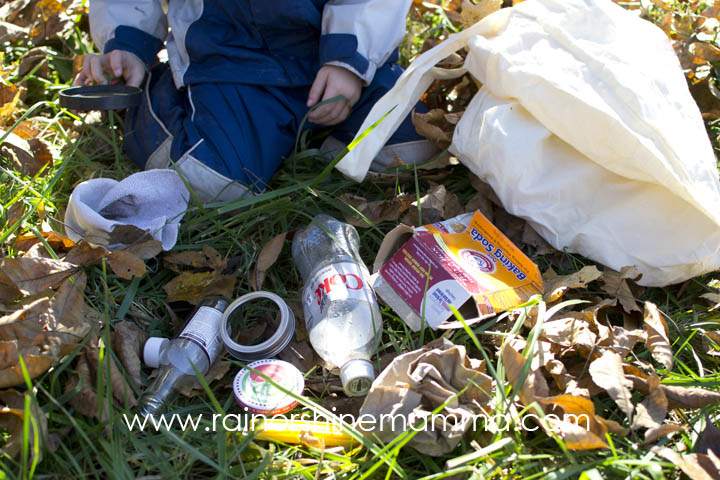The core of the Scandinavian forest school pedagogy is made up of unstructured play outdoors. That said, forest school teachers often offer different invitations to investigate or delve deeper into certain things, to see what might interest the children. Some, like this fun and simple forest school activity, are designed to instill environmental stewardship. I’ve done it with my girls several times and it’s always a great conversation starter that makes them think a little deeper about waste, littering and consumption. This forest school activity can be done either with an individual child or as a group.
Time: 30 min+
Materials:
- 15-20 small, common household items made from various materials, for example glass, cardboard, metal, wood, plastic, paper, fabric etc.
- Tote bag
Place: A park, natural area or your own backyard
How to do it: Choose an area and spread out the items while the child is not watching. You can vary the level of difficulty depending on the child’s age – ranging from very easy to find for a young preschooler to slightly camouflaged/hidden for a first grader. Give him/her the tote bag and discuss how you can recognize things that don’t belong in nature, then start hunting!
For younger kids, try telling a little story to lead into the activity, for example: “I think a Litter Bug has been here and dropped some things that don’t belong in nature. Let’s see if we can find them and pick them up!” As you come across the planted items, ask “Does that belong in nature?” and let the child make the call. Mix it up by picking up some natural items as well and asking the same question. Then talk about why some things belong and others don’t.
Variations: If littering is a problem where you live, why not make this a community service activity with the kids? Unfortunately, in our area a lot of the littering happens along busy highways, where it’s not safe to pick up litter with children, but whenever we see litter on our walks we try to pick up what we can and talk about what doesn’t belong in nature.
One of the pillars of forest school pedagogy is child-led learning, and to this end I always ask a lot of questions when we do these activities. The goal is not for me to simply transmit knowledge, but for the girls to think for themselves and reach their own conclusions. My role is to get their wheels turning.
These are some questions that might useful for this session:
- Are some materials more “natural” than others?
- Where does all the trash go when we throw it “away”?
- What can happen to plants and animals when things that don’t belong in nature end up there?
- How long does it take for the trash to biodegrade?
- What can we do to take care of nature?
When I did this forest school activity with my youngest daughter, who was almost 4 at the time, she had a lot of thoughts on these topics. “Litter can hurt the animals in the forest,” she said. “If there is glass on the ground they can step on it and get hurt, or if they eat it they can die.” Both very good points and good reasons why it’s so important to start talking about these things early.
More forest school activities:
Outdoor Math Activity: Count to 10 with Nature
Outdoor Science Activity: Small World Exploration
Sorting, Comparing and Categorizing: Forest-School Inspired Activities for Preschoolers
Word Hunt in Nature






I love this idea!
Thank you, Heather! My daughter loved it and has asked to do it again several times.
This is a great idea, a fun activity and some learning too. I really like this, so much so I’m pinning it as a possible idea for our acrtivity hour here on the farm, I could also add in things that are harmful for animals to eat, all sorts of possibilities. Thank you for the idea and for sharing on Country Kids.
I love this post and I love how you made this activity fun for kids by introducing it gently! I’m so going to do this with my twinnies!
Thank you, Penny! Always love to hear when somebody feels inspired by an activity:o)
This is such a great idea, we often have environmental talks when in Forest School and littering is a huge part. I love seeing the children making sure their litter goes in the bags and nothing is left when we leave. I hope that its a life lesson that will stay with them as they grow up.